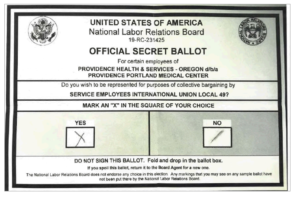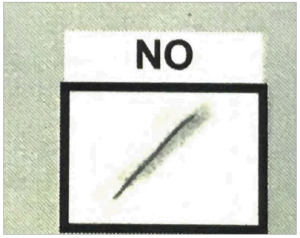One area of controversy over the years is the NLRB's attempt to interpret markings on representation ballots that are not clearly "yes" or "no." This has given rise to a number of tests for divining voter intent. Overruling decades of conflicting precedent involving the interpretation of a voter's intent, the NLRB issued a key decision on May 14, 2020, establishing a bright-line rule regarding the validity of ballots with markings in both the "Yes" and "No" boxes, or stray marks outside the boxes. From this point forward, dual markings or stray markings on the ballot will result in the vote being void.
In Providence Health & Services 369 NLRB No. 78 (2020), the Board found that to determine the validity of ballots with dual or additional marks, its previous decisions required an inherently subjective determination of whether the voter's intent could be "ascertained from other markings on the ballot (such as an attempt to erase or obliterate one mark)."
Stating that the Board did not have special expertise in determining voter intent based on markings, and that the inquiry was subjective and relied on speculation, the Board established a bright-line rule: all ballots with markings in more than one box or square are void. The Board modified the language included in election ballots to better reflect this new standard, and encourage voters to obtain a new ballot if they accidentally make additional marks.
The Closest Representation Election
The factual circumstances addressed by the Board is the nightmare scenario envisioned by every party to a representation election: that the vote is so close that one or two ballots in dispute can decide the outcome. A manual union election was held, resulting in a final tally of 383 votes for representation, 382 votes against representation, and two void ballots after all challenges had been resolved. Union certification requires a majority of ballots to be cast in favor of representation, rendering each of the void ballots potentially dispositive. The key ballot at issue ("Ballot 1") contained a diagonal line in the "No" square and an "X" in the "Yes" square.


The Board Agent declared Ballot 1 void, but at the parties' hearing on challenges and objections, the administrative law judge recommended that it should be counted as a vote in favor of representation. Upon review, the Regional Director looked to prior Board precedent holding that a dual-marked ballot is void unless the voter's intent can be "ascertained from other markings on the ballot (such as an attempt to erase or obliterate one mark)." The Regional Director agreed with the judge, stating that the smudge along the diagonal line in the "No" box was an "obvious attempt at erasure of an incomplete 'X'". Concluding that it was possible to discern the "clear expression of the voter's intent" based on the markings, the Regional Director held that Ballot 1 was a valid vote in favor of representation, and thus the union was to be certified, on a vote of 384 votes in favor of representation and 383 votes against representation.
The Board's Examination of Prior Precedent
The Board's earliest attempts to determine the validity of irregularly marked ballots often had conflicting outcomes. Compare Iroquois China Co., 55 NLRB 290 (1944) (holding that ballot with "X" in "Yes" square and diagonal line in "No" square was void) with Belmont Smelting & Refining Works, Inc., 115 NLRB 1481 (1956) (finding ballot with a "X" in one square and diagonal line in other square to be valid and counted for the choice with the "X").
In Caribe Industrial & Electrical Supply, Inc., 216 NLRB 168 (1975) and TCI West, Inc., 322 NLRB (1997), the Board attempted to reconcile its prior decisions, and held that the inquiry in cases involving irregularly marked ballots was to determine whether the voter's intent can be "ascertained from other markings on the ballot (such as an attempt to erase or obliterate one mark)." If the voter's intent is not discernable, the ballot is void. TCI West, Inc., 322 NLRB at 928.
The Board noted that while the TCI West Board's description of the general rule was accurate, its application was "far from clear or consistent." The Board cited numerous cases where the Board relied on either the presence or the absence of "clear" markings or erasures to determine the validity of a ballot. These cases illustrate the "seemingly limitless variety" of irregular markings, and the difficulty of interpreting such markings objectively. The decisions have turned on minor details, such as whether the Board considered a mark to be a smudge or attempted erasure, whether extra lines suggested obliteration attempts in the absence of an eraser, whether extra lines were attempts at emphasis, and whether an asterisk was the same as an "X".
Indeed, the 9th Circuit, in reviewing TCI West, stated that prior Board precedents demonstrate that "determining whether a voter has attempted erasure is just as subjective as determining the voter's intent." TCI West, 145 F.3d 1113 (9th Cir. 1998). In the instant case, while there is no dispute that the diagonal line in the "No" square is smudged, it is open to interpretation whether this is due to an intentional attempted erasure, or the result of the voter's sweaty hands or the manner in which the ballot was folded.
Therefore, the Board concluded that "determining voter intent based on markings that could be completely unintentional is beyond the Board's special expertise, is susceptible to becoming a subjective inquiry, and ultimately rests on speculation of the sort the Board has otherwise committed itself to avoid." Nor was it an efficient use of agency resources to attempt to make such a determination.
Establishing a Bright-Line Rule
The Board established a bright-line rule that all ballots that include markings in more than one square or box are void. This applies not only to highly ambiguous markings, such as the ones in the instant case, but also ballots in which the intent of the voter is more easily discerned, as was at issue in Thiele Industries, 325 NLRB 1122 (1998), where the ballot had a diagonal line in the "No" square, a "X" in the "Yes" square, and a hand-drawn circle around the word "Yes". All prior decisions are overruled to the extent that they disagree with the new rule.
In addition, the Board modified the official election ballot language to encourage voters to obtain a new ballot should they make any stray marks. The previous language stating, "If you spoil this ballot, return it to the Board Agent for a new one" was replaced with "If you make markings inside, or anywhere around, more than one square, return your ballot to the Board Agent and ask for a new ballot. If you submit a ballot with markings inside or anywhere around more than one square, your ballot will not be counted."
Finally, the Board applied its bright-line rule retroactively to the instant case, finding that the parties had not relied on the previous decisions, and would not be prejudiced by the retroactive application. Accordingly, the ballot at issue was void, and the union was not certified.
Takeaways
Despite a representation vote being a seemingly simple "Yes" or "No" choice, voters continue to submit ballots where the choice is not clear-cut. This continued to happen even with the old language warning voters to seek a new ballot if they made stray markings. This is why it is important to educate voters as to how to properly vote so that their ballot will be counted. The Board's decision clarifies balloting procedures for both unions and employers. While it is possible more ballots will be voided under this rule, at least every party now understands clearly which ballots will be counted and which ballots will be voided.
NLRB Establishes Bright-Line Rule Voiding Election Ballots With Dual Or Additional Markings
Article originally published on 15 May 2020
The content of this article is intended to provide a general guide to the subject matter. Specialist advice should be sought about your specific circumstances.


